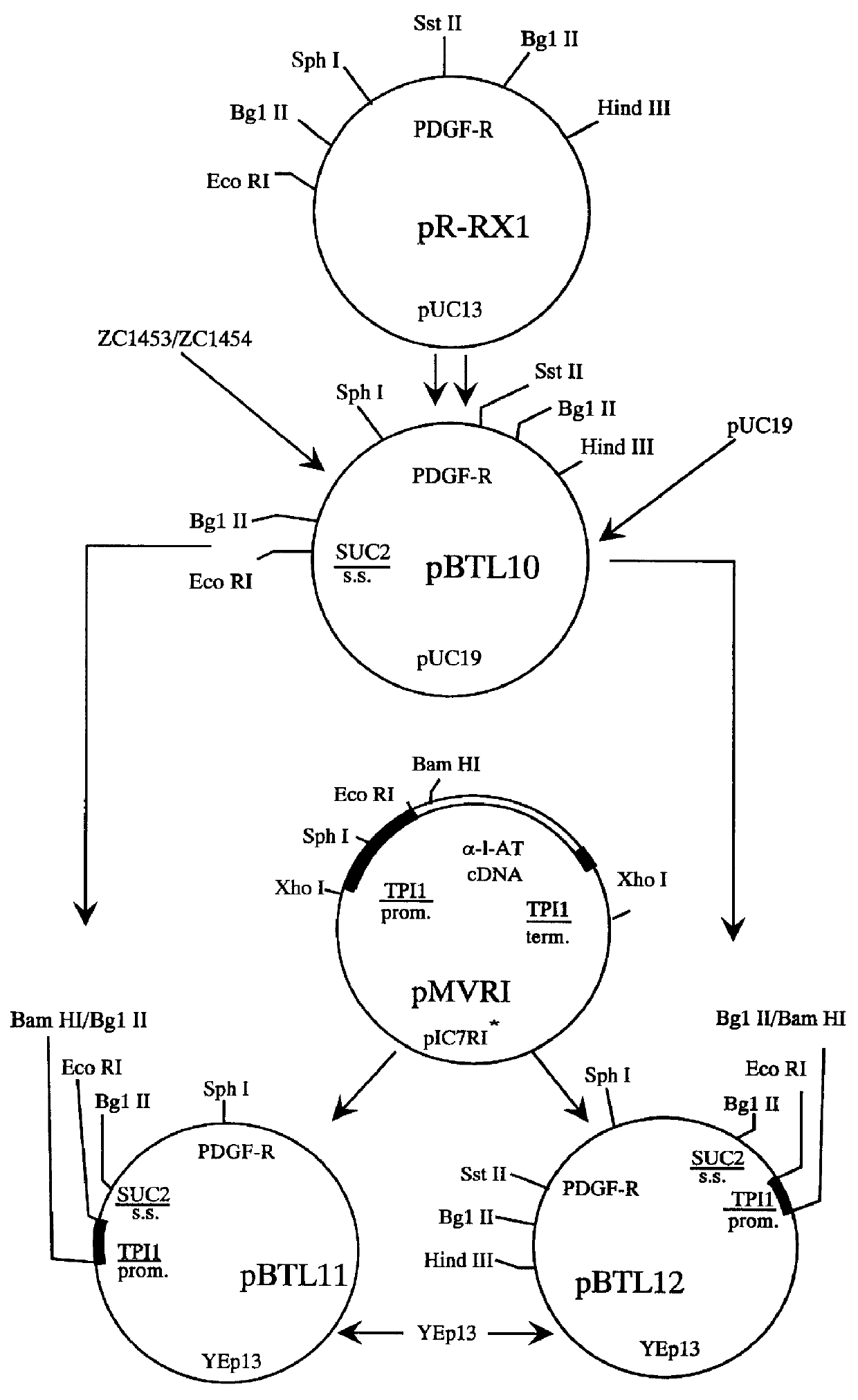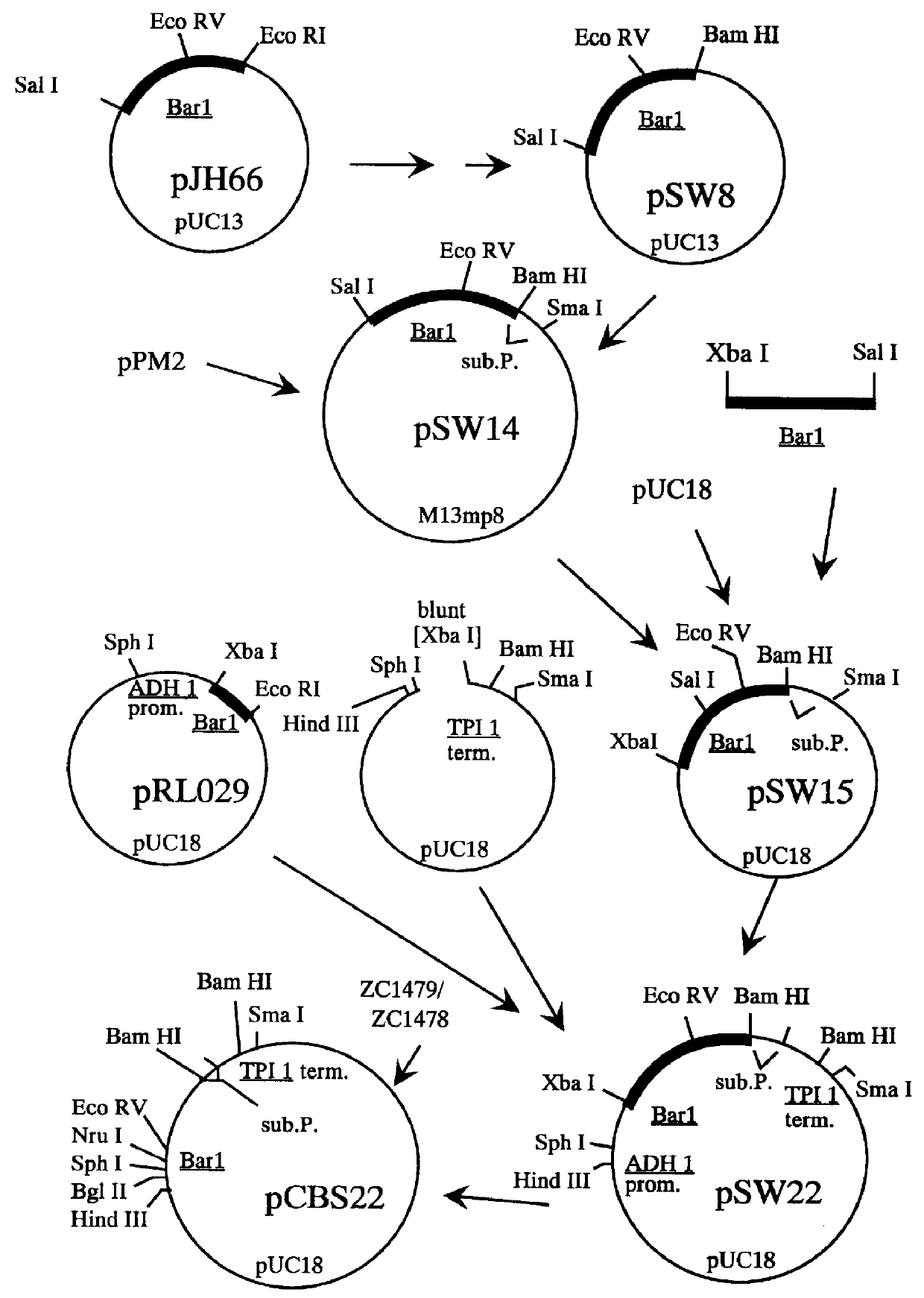Biologically active dimerized and multimerized polypeptide fusions
a polypeptide, multi-merization technology, applied in the direction of peptides, peptide sources, peptide/protein ingredients, etc., can solve the problems of difficult to maintain high biological activity and biochemical purity of receptors, difficult to find a functionally equivalent molecule to the original ligand, etc., to achieve the effect of increasing expression levels
- Summary
- Abstract
- Description
- Claims
- Application Information
AI Technical Summary
Benefits of technology
Problems solved by technology
Method used
Image
Examples
example 1
A. Cloning the PDGF .beta.-Receptor
A cDNA encoding the PDGF .beta.-receptor was cloned as follows. Complementary DNA (cDNA) libraries were prepared from poly(A) RNA from diploid human dermal fibroblast cells, prepared by explant from a normal adult, essentially as described by Hagen et al. (Proc, Natl. Acad. Sci. USA 83: 2412-2416, 1986). Briefly, the poly(A) RNA was primed with oligo d(T) and cloned into .lambda.gtll using Eco RI linkers. The random primed library was screened for the presence of human PDGF receptor cDNA's using three oligonucleotide probes complementary to sequences of the mouse PDGF receptor (Yarden et al., Nature 323: 226-232, 1986). Approximately one million phage from the random primed human fibroblast cell library were screened using oligonucleotides ZC904, ZC905 and ZC906 (Table 1; Sequence ID Numbers 5, 6 and 7, respectively). Eight positive clones were identified and plaque purified. Two clones, designated RP41 and RP51, were sel...
example 2
Construction of a SUC2 Signal Sequence-PDGF .beta.-Receptor Fusion
To direct the PDGF .beta.-receptor into the yeast secretory pathway, the PDGF .beta.-receptor cDNA was joined to a sequence encoding the Saccharomyces cerevisiae SUC2 signal sequence. Oligonucleotides ZC1453 and ZC1454 (Sequence ID Numbers 10 and 11; Table 1) were designed to form an adapter encoding the SUC2 secretory signal flanked by a 5' Eco RI adhesive end and a 3' Bgl II adhesive end. ZC1453 and ZC1454 were annealed under conditions described by Maniatis et al. (ibid.). Plasmid pR-RX1 was digested with Bgl II and Sst II to isolate the 1.7 kb fragment comprising the PDGF .beta.-receptor coding sequence from amino acids 28 to 596. Plasmid pR-RX1 was also cut with Sst II and Hind III to isolate the 1.7 kb fragment comprising the coding sequence from amino acids 597 through the translation termination codon and 124 bp of 3' untranslated DNA. The two 1.7 kb pR-RX1 fragments and the ZC1453 / ZC1454 adapter were joined w...
example 3
Construction of pCBS22
The BAR1 gene product, Barrier, is an exported protein that has been shown to have three domains. When used in conjunction with a first signal sequence, the third domain of Barrier protein has been shown to aid in the secretion of proteins into the medium (MacKay et al., U.S. patent application Ser. No. 104,316).
The portion of the BAR1 gene encoding the third domain of Barrier was joined to a sequence encoding the C-terminal portion of substance P (subP; Munro and Pelham, EMBO J. 3: 3087-3093, 1984). The presence of the substance P amino acids on the terminus of the fusion protetn allowed the protein to be detected using commercially available anti-substance P antibodies. Plasmid pZV9 (deposited as a transformant in E. coli strain RR1, ATCC accession no. 53283), comprising the entire BAR2 coding region and its associated flanking regions, was cut with Sal I and Bam HI to isolate the 1.3 kb BAR1 fragment. This fragment was subcloned into pUC13, which had been cu...
PUM
| Property | Measurement | Unit |
|---|---|---|
| Biological properties | aaaaa | aaaaa |
| Light | aaaaa | aaaaa |
Abstract
Description
Claims
Application Information
 Login to View More
Login to View More - R&D
- Intellectual Property
- Life Sciences
- Materials
- Tech Scout
- Unparalleled Data Quality
- Higher Quality Content
- 60% Fewer Hallucinations
Browse by: Latest US Patents, China's latest patents, Technical Efficacy Thesaurus, Application Domain, Technology Topic, Popular Technical Reports.
© 2025 PatSnap. All rights reserved.Legal|Privacy policy|Modern Slavery Act Transparency Statement|Sitemap|About US| Contact US: help@patsnap.com



